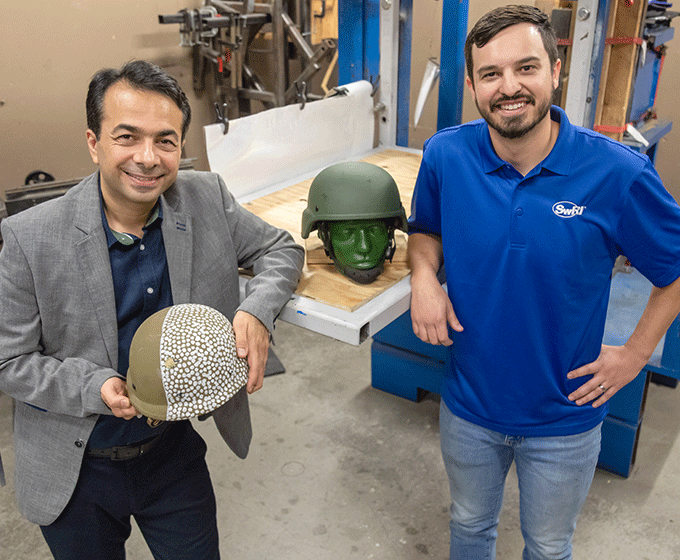
UTSA’s Dr. Morteza Seidi (left) and SwRI’s Dr. Daniel Portillo (right) are creating innovative military helmet pads designed to prevent traumatic brain injury (TBI). The project is supported by a $125,000 grant from the Connecting through Research Partnerships (Connect) program. Photo Courtesy of SwRI.
SEPTEMBER 16 2024 — Researchers from Southwest Research Institute (SwRI) and UTSA are creating innovative military helmet pads designed to prevent traumatic brain injury (TBI). The project, led by SwRI’s Daniel Portillo and UTSA’s Morteza Seidi, is supported by a $125,000 grant from the Connecting through Research Partnerships (Connect) program.
Traumatic brain injury can affect human performance and quality of life. It is a critical concern in military settings, where service members are regularly exposed to environments that pose significant risks for blast exposures, blunt trauma and ballistic impacts.
“The increasing incidence of TBI among military service members shows a pressing need for enhanced protective equipment in combat and training environments,” Portillo said. “The widespread use of improvised explosive devices and firearms has made TBIs particularly prevalent, and helmets are the primary form of protection against skull and brain injuries.”
SwRI and UTSA will collaborate on a helmet that includes multi-behavior padding that becomes soft or stiff depending on the type of impact the wearer experiences. During a blunt impact, such as a fall, the padding will soften to cushion against the blow. A ballistic impact from shrapnel or a bullet will make the padding stiffen to absorb the object’s kinetic energy and prevent injury to the skull and brain.
“Ballistic impacts occur at extremely high speeds,” Seidi said. “They are very different from blunt impacts at relatively lower speeds, which is why it’s challenging to create a helmet that can protect against both.”
SwRI’s Dan Nicolella and UTSA’s Marzieh Memar will lead the computer analysis of human brain response to evaluate the overall performance of padding in reducing the likelihood of brain injury.
The researchers will use 3D printing technology to build the helmet pads, and then test their ability to mitigate injury under various levels of both types of impacts, simulating real-world conditions. Blunt impact testing will occur at UTSA, while SwRI will conduct ballistic impact testing.
“By leveraging the unique expertise at UTSA and SwRI, we can improve the safety and wellbeing of military service members,” Portillo said.
SwRI’s Executive Office and the UTSA Office of Research sponsor the Connect program, which offers grant opportunities to enhance greater scientific collaboration between the two institutions.
UTSA Today is produced by University Communications and Marketing, the official news source of The University of Texas at San Antonio. Send your feedback to news@utsa.edu. Keep up-to-date on UTSA news by visiting UTSA Today. Connect with UTSA online at Facebook, Twitter, Youtube and Instagram.
Día en la Sombrilla, formerly Fiesta UTSA, is a festival hosted each spring as a part of Fiesta® San Antonio events. Sponsored by Roadrunner Productions, the event features music, food, confetti, games, event t-shirts, and more.
Sombrilla Plaza, Main CampusCovidence is a systematic & scoping review tool used to streamline the process of screening and reviewing articles. Using this software, research teams can easily import studies, perform automatic deduplication, and extract data using templates. This workshop will show attendees how to start a review in Covidence, add collaborators, and get started on screening.
Virtual (Zoom)In this workshop, attendees will be introduced to Pandas, a Python tool for working with data easily. It makes it simple to organize and analyze information when data is organized and categorized, like spreadsheets or tables.
Group Spot B, John Peace LibraryEach fall and spring semester, students convene at the Main Campus at UTSA with booths, ideas and prototypes. A crowd of judges, local organizations, students, faculty and sponsors walk around and talk to the students about their projects and ask questions. Students get the real-life experience of "pitching" their project with hopes of getting funding or support to move to the next level.
UTSA Convocation Center, Main CampusJoin the doctoral candidates for the Doctoral Conferreal Ceremony and celebrate their accomplishments.
Arts Building Recital Hall, Main CampusCelebrate the graduates from the Carlos Alvarez College of Business, College of Education and Human Development, Margie and Bill Klesse College of Engineering and Integrated Design and University College.
AlamodomeCelebrate the graduates from the College for Health, Community and Policy, College of Liberal and Fine Arts and College of Sciences.
AlamodomeThe University of Texas at San Antonio is dedicated to the advancement of knowledge through research and discovery, teaching and learning, community engagement and public service. As an institution of access and excellence, UTSA embraces multicultural traditions and serves as a center for intellectual and creative resources as well as a catalyst for socioeconomic development and the commercialization of intellectual property - for Texas, the nation and the world.
To be a premier public research university, providing access to educational excellence and preparing citizen leaders for the global environment.
We encourage an environment of dialogue and discovery, where integrity, excellence, respect, collaboration and innovation are fostered.